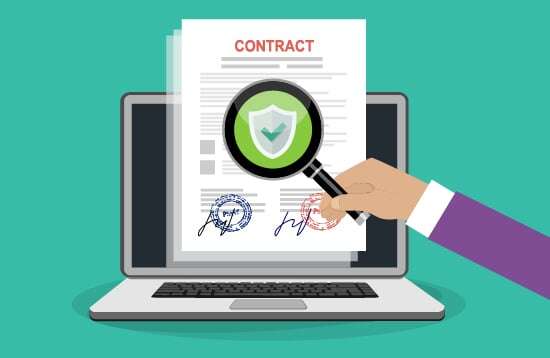Sufficient vendor contract management encompasses a well-managed process for handling all agreements with your organization’s third parties from start to finish. This includes all aspects of the contracts, from standards on what should be included, to who is authorized to sign, to how they are centrally stored, to how they are tracked, to key provisions that must be included, to how your customers’ information is protected and much more.
What to Know About Vendor Contract Management
There’s a lot to keep in mind, but to help get you started, here are 6 vendor management contract principles that you need to know:
- Clearly define contract ownership. Within your organization, clearly define contract signing authority and the internal processes required post signature.
- Review contracts frequently. Pull out those evergreen contracts on a recurring basis, take a quick look and make sure there are no surprises lurking. Revisiting a contract isn’t always about price. Although, at the very least, a moderate loyalty discount could be requested if you plan to give them a longer term.
Review time is your opportunity to:
- Address any performance issues
- Upgrade, if warranted
- Have a compliance conversation with non-compliant vendors
- Check the contract against your industry’s guidance and correct any gaps
- Validate the risk vs. the reward of the relationship
- Do a market check to make sure you have the right product or service at a fair price
- Refine or redefine service level agreements (SLAs). If you don’t have SLAs in your contract, now is the time to fix that! SLAs are likely to be your only recourse with an underperforming vendor. And don’t forget, poor performance can be defined many ways. What if your vendor is not financially healthy or has displayed recent security concerns? This could lead to poor delivery or a failure to meet security standards. While you won’t likely get termination provisions for poor financial performance, you can get termination provisions for failure to deliver. We can’t stress enough how important SLAs are to your ability to exit a contract when you have the wrong vendor.
- Understand the inherent risk of the vendor and address that in the contract, too. For example, if it’s disastrous to your organization if that vendor is hacked, then define the information security expectations clearly as well as notification and remediation requirements. If your vendor won’t comply, replace them. Compliance isn’t optional for you. It never should be for them either.
- Use a reliable tool. Among the most worrisome contractual dangers are missing key dates, such as allowing a contract to auto-renew because you missed the date to notify an underperforming vendor that your organization “wants out.” Invest in a system (not Outlook or Excel) to track significant dates.
Pro Tip: Even if one person in your organization ultimately owns a vendor relationship/contract, make sure more than one staff member receives auto-renewal notifications.
- Never enter a contract without a legal review. Don’t mistake a legal review for a compliance review. Your lawyers will protect your liability but, depending on their level of experience with regulatory compliance, they could miss the issues that make it difficult for you to meet your ongoing due diligence requirements.
Contract management isn’t easy – it requires a commitment, not only by the parties involved, but by your entire organization to make sure that agreements are controlled, centrally managed and uniformly enforced. Hopefully, instilling some of these principles will help streamline your organization’s approach to vendor contract management.
Strong vendor contract management is really all about negotiation and execution. Download the infographic.




